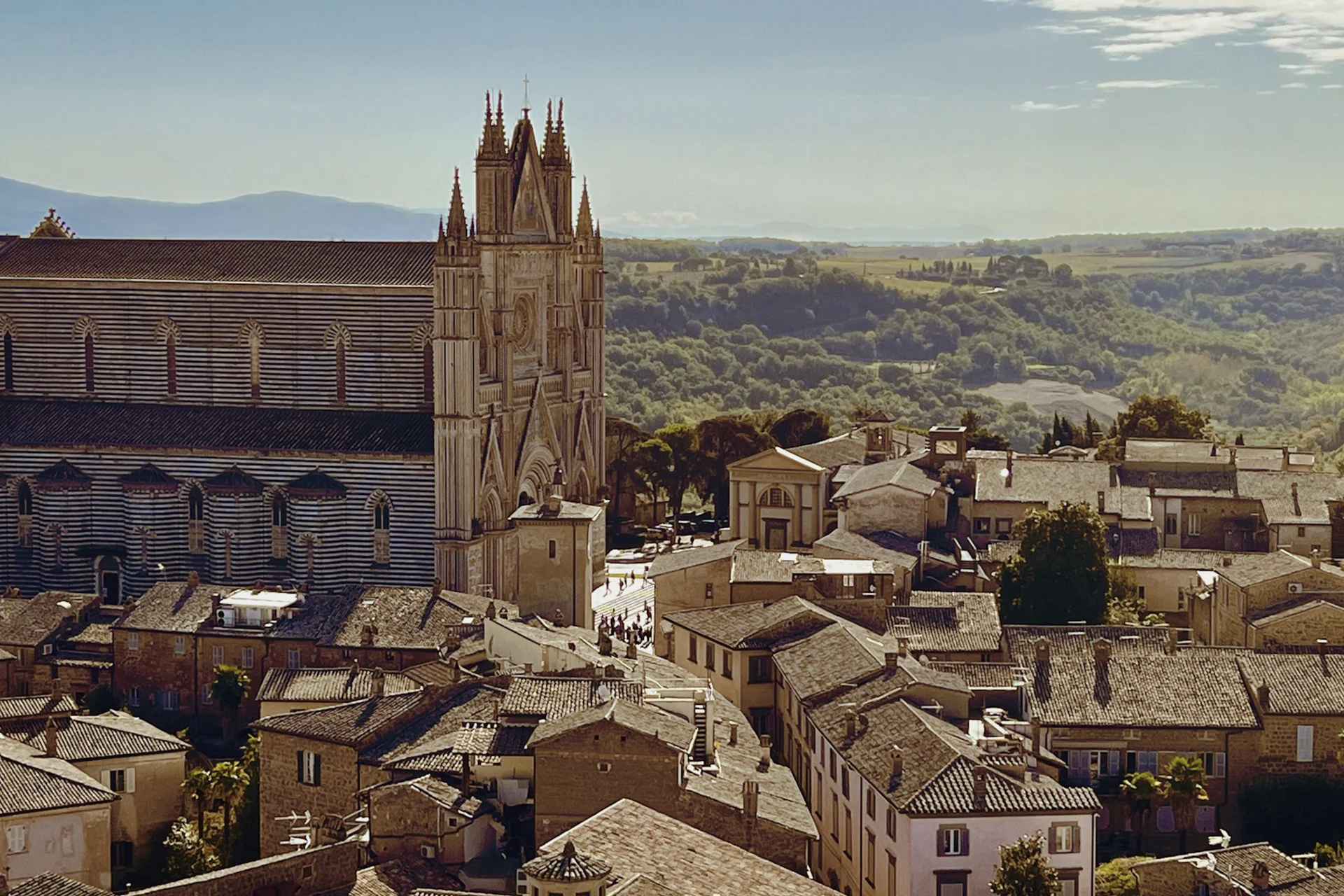
LATITUDE
LONGITUDE
APPELATIONS
Orvieto DOC isn’t just a historic Italian wine region; it’s a masterclass in terroir-driven white wine. A place where ancient Etruscan soils and Renaissance cityscapes collide over glasses of Grechetto and Trebbiano, and where each sip tastes of sunlit volcanic cliffs and elevation.
This in-depth guide slices straight to the heart of Orvieto DOC: geography, history, terroir, grape varieties, wine styles, food pairings, top wineries, and sustainability practices. If you want to know whether Orvieto is the next breakout white for your cellar or dinner table, read on.
Orvieto DOC straddles the southwestern pocket of Umbria and encroaches slightly into Lazio, spanning a dramatic plateau above the Paglia River valley. While generally associated with Umbria, a crucial slice of Orvieto DOC falls within Lazio’s Viterbo province, lending a Roman backbone to the area’s identity. The city of Orvieto, perched on a volcanic tuff outcrop, anchors the region both geographically and culturally.
The region is dotted with dramatic lakes. Lago di Corbara is one of the key lakes in the area, contributing to the local climate and fostering the humidity that encourages botrytis, which is essential for the production of Orvieto’s renowned sweet wines.
While nearby high-profile regions tilt red (think: Tuscany, Montepulciano), Orvieto DOC’s altitude, volcanic soils, and cooling breezes are white wine catnip: driving focus, minerality, and that signature snap of acidity. The majority of Orvieto wine is produced on the Umbrian side of the border, further emphasizing the region’s connection to this central Italian heartland.
.jpg)
*GDD estimate based on Winkler Index, Region II–III, with vineyards exposed to significant diurnal variation.
Key Takeaway: With vineyards climbing to nearly 500 meters, double the “sweet spot” for some Italian whites, Orvieto’s elevation and sheer vertical sweep bring lively freshness and complexity to the wines.
Picture Orvieto’s skyline: honey-coloured medieval towers thrust above Etruscan caves and Roman roads.

Vineyard Hectares
WINERIES
GROWING DEGREE DAYS
The Orvieto region, straddling the picturesque landscapes of Umbria and Lazio, is renowned for its rolling vineyards, dramatic lakes, and the iconic hilltop city of Orvieto. This area has been producing wine since the Middle Ages, and its legacy is woven into every bottle.
Orvieto DOC sprawls across undulating hills, with steep slopes plunging down towards rivers. The Orvieto “Classico” zone marks the historic core near the city, where soils, elevation, and exposure are most ideal. This area comprises around 1,500 hectares of vineyards, making it a concentrated hub of quality production within the broader DOC.
The Orvieto region experiences a Mediterranean climate with continental influences at higher elevations. Warm, sunlit days and cool nights create diurnal swings up to 12°C (21°F) in late summer, while well-distributed rainfall—interrupted by dry summers—helps stress vines beneficially, contributing to focus and intensity in the wines.
Volcanic tuff, pozzolana, clay, sand, and fossil-rich sandstone are the dominant players. Classic Orvieto soils are volcanic: light, porous, and mineral-laden, offering ideal water retention even in summer heat. Roots dig deep, extracting a nervy minerality that’s the region’s core calling card. Fossil-shell sands (often found in sub-zones) add complexity: think saline bite and lemon zest.
Orvieto DOC isn’t just a historic Italian wine region; it’s a showcase of native and traditional grapes. Whites feature Grechetto, Procanico (Trebbiano Toscano), Verdello, Malvasia Toscana, and Drupeggio (Canaiolo Bianco), while reds under Rosso Orvietano DOC include Sangiovese, Merlot, Cabernet Sauvignon/Franc, and local varieties like Montepulciano and Canaiolo.
.jpg)
.jpg)
The DOC disciplines ensure Grechetto and Procanico (combined, minimum 60% for Orvieto DOC) sit at the heart of the white blend—no other ingredient delivers the signature almond, saline, citrus profile. Procanico (a biotype of Trebbiano Toscano) contributes acidity and delicate florals to the wine, enhancing its balance and aromatic complexity.
Orvieto wines range from bright and zesty dry styles, lightly sweet Amabile, off-dry Abboccato, and fuller-bodied Superiore, to elegant Classico, luscious Muffa Nobile, spicy Vendemmia Tardiva, and juicy Rosso Orvietano reds—showcasing the region’s full spectrum of styles.
.jpg)
Recommended Tasting Approach: Many wine professionals and enthusiasts choose to review three wines from Orvieto DOC in a single tasting session: often a dry white, a sweet Muffa Nobile, and a Rosso Orvietano red. This approach allows for direct comparison and evaluation of the region’s stylistic diversity, helping tasters appreciate the unique qualities and flavour profiles of each wine.
Orvieto’s prized acidity and mineral drive make these wines chameleons at the table. Forget the sommelier rulebook: imagine a Roman trattoria on a volcanic cliff, with citrusy Orvieto chilling in a carafe and shared meals loading up fast. Orvieto wine is highly versatile and pairs well with appetizers, seafood, fish, white meats, and cheeses, making it a go-to choice for a variety of dining experiences. Orvieto wines are especially enjoyable when paired with a traditional Italian meal, enhancing both the food and the wine for an authentic dining experience.
.jpg)
With Orvieto, when in doubt: match minerality with brininess, acidity with fat, and aromatic wines with herbed or truffled dishes. There is no more versatile Italian white under $25.
Orvieto DOC pairs stunning landscapes with some of central Italy’s most authentic enotourism experiences:
Visiting the area means more than just tasting wine. It’s about diving into the living connection between the land, the wine, and the legacy of a hilltop city that’s seen it all. Visiting local producers lets you experience estate-grown wines that reflect each producer's unique vision and terroir.
Famous producers of Orvieto wines include Antinori, Barberani, and Decugnano dei Barbi, who have contributed significantly to the region's reputation for quality and innovation.
.jpg)
These estates blend tradition and innovation. Palazzone and Tenuta di Salviano excel with single-vineyard bottlings showcasing Orvieto’s top end, while Madonna del Latte’s artisanal micro-cuvées are catnip for natural wine fans.
Orvieto’s environmental story is one of adaptation and proactive sustainability:
Orvieto’s push toward sustainability isn’t just trend-chasing; it’s baked into the region’s DNA, where resilience against shifting markets and climate is a centuries-old skill.